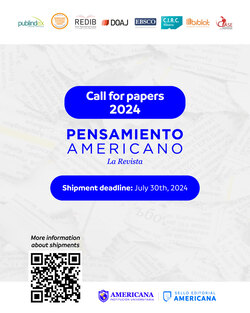LA DANZA DEL DIABLO: ESTE?TICAS-RITUALES-COMUNITARIAS EN LA MIXTECA OAXAQUEN?A
DOI:
https://doi.org/10.21803/pensam.v7i13.98Palavras-chave:
Diablo, Estética, Ritual, Identidad, Semiosfera, CronotopoResumo
La imagen del diablo que trajeron los evangelizado- res, junto con la espada del conquistador, fue el resultado de un largo proceso socio-histo?rico-poli?tico-cultural. La espada y la cruz necesitaban herramientas de control ideolo?gico a trave?s del miedo, la culpa, la amenaza del infierno. Esta imagen fue utilizada por las o?rdenes mo- na?sticas para emprender la lucha contra la idolatri?a, cuya premisa fue la total extirpacio?n del “paganismo”; usando como estrategia la satanizacio?n de los dioses del Mesoamericanos. El Mal tiene una de tantas encarnaciones dentro del contexto festivo actual en el calendario de la mixteca oaxaquen?a, a trave?s de la puesta en escena de la Danza de Diablos. Para el ana?lisis de esta danza se propone la categori?a transdisciplinaria de este?ticas-rituales-comunitarias, la cual muestra como se reproduce lo simbo?lico en la memoria ancestral de la cultura, y como la figura del mal esta? presente en las cosmovisiones mixtecas contempora?neas.
Abstract
The image of the devil that brought the evangelizers, along with the sword of the conqueror, was the result of a long process socio-historical-political-cultural. The sword and the cross needed tools of ideological control through fear, the guilt, the threat of hell. This image was used by the monastic orders to take up the fight against the idolatry, whose premise was the complete removal of the “paganism”; using as a strategy the demonization of the gods of the Mesoamericans. The evil is one of many incarnations within the current context in the festive calendar of the Mixteca Oaxacan, through the implementation of the dance scene of Devils. For the analysis of this dance, it is proposed that the transdisciplinary category of aesthetic-ritual-community, which shows how symbolic it is reproduced in the ancestral memory of the culture, and as the figure of the evil is present in the Mixtec contemporary worldviews.
Downloads
Referências
Bajtin, M. (1989). Teoría y estética de la novela. Madrid: Taurus.
Bartolomé, M. (1997). Gente de costumbre y gente de razón. Las identidades étnicas en México. México: Siglo XX-INI.
Cárdenas, M. (2011). De la sirena a la mujer hay un mar de imaginarios... Hacia el erotismo metafórico de la estética ritual. En H. Julieta, & G. Sánchez, La arquitec- tura del sentido II (pp. 157-196). México: INAH-ENAH.
Díaz, R. (1998). Archipiélago de rituales. Teo- rías antropológicas del ritual. Barcelona: Anthropos-UAM.
Guerra, S. & Stefani, G. (2004). La globalidad de lenguajes, Antropología, Semióti- ca, Pedagogía. México: CONACUL- TA-INAH-ENAH.
Haidar, J. (1994). Las prácticas culturales como prácticas semiótico-discursivas. En González y Galindo Cáceres (eds.), Metodología y cultura. México: CONA- CULTA.
Haidar, J. (2005). El análisis del sentido: pro- puestas desde la complejidad y la trans- disciplina. En J. Haidar, La arquitectura del sentido. La producción y reproducción de las prácticas semiótico-discursivas (pp. 409-435). México: CONACUL-TA-INAH.
Haidar, J. (2006). Debate CEU-Rectoría. Torbellino pasional de los argumentos. México:UNAM.
Lotman, I. (1996). Acerca de la semiosfera. En Semiótica de la cultura I. Semiótica de la cultura y del texto. Madrid: Ediciones Cátedra.
Mindek, D. (2003). Mixtecos. México: CDI- PNUD.
Paz, O. (1987). Los privilegios de la vista. Arte de México. México: Fondo de Cultura Económica.
Downloads
Publicado
Edição
Seção
Licença
Copyright (c) 2014 Pensamiento Americano

Este trabalho está licenciado sob uma licença Creative Commons Attribution-NonCommercial-NoDerivatives 4.0 International License.
The author or authors of an article accepted for publication in the Journal Pensamiento Americano will transfer all of the patrimonial rights to the American University Corporation free of charge, within which are included: the right to edit, publish, reproduce and distribute both print media as digital, in addition to include in article in international indexes and / or databases, likewise, the Editorial Seal is authorized to use the images, tables and / or any graphic material presented in the article for the design of covers or posters from the same magazine. By assuming the patrimonial rights of the article, it may not be partially or totally reproduced in any printed or digital media without its express permission.
AUTHORITY ASPECTS
For the Pensamiento Americano Journal, all the authors of an article have made substantial contributions to the research and the manuscript, and they share the responsibility when the article presents errors, fraud in some way or violations of copyright.
After submitting an article, the journal does not accept the addition, deletion or change in the order of the authors, in addition we reserve the right to release the article when it has been submitted to the journal and under no circumstances will American Thought accept the article. withdrawal of an article during any phase of the editorial process






